Month: January 2022
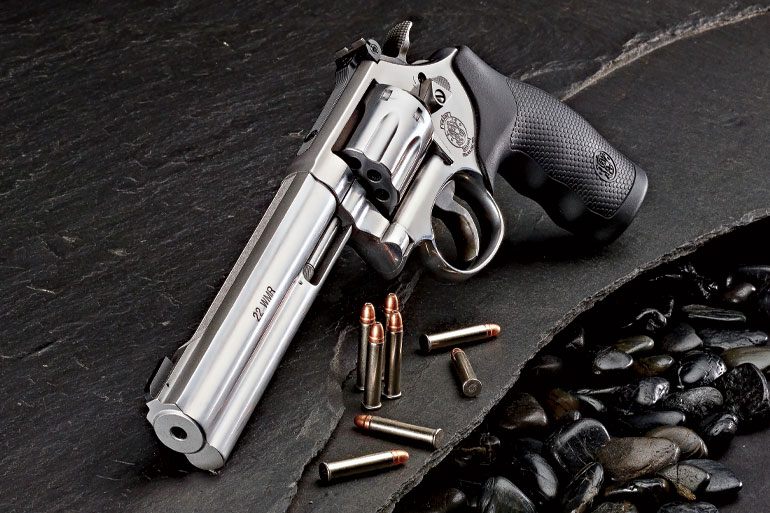
The Smith & Wesson Model 648 .22 WMR Revolver works well as a small-game-hunting tool and camp/trail gun, but it’s also great for casual target shooting and plinking.
The .22 Winchester Magnum Rimfire (WMR), a.k.a. .22 Magnum, is one of my favorite cartridges. Growing up and living my whole life in Illinois, where I have been limited to hunting with rimfires, shotguns, and muzzleloaders (except for coyotes that can be hunted with centerfire rifles), I’ve hunted a lot of small game and varmints with the .22 Magnum. It’s an accurate cartridge, and as more than one old-timer has stated, its ballistics out of a 6.0-inch-barreled handgun are equal to or better than .22 LR ballistics out of a 24-inch-barreled rifle. I’ve lost track of the number of .22 Magnum guns I’ve owned and tested over the years, but two of my favorites were a vintage S&W Model 48 double-action revolver and a Winchester Model 9422 XTR lever-action rifle. However, I think the brand-new S&W Model 648 may have taken over the top slot on my favorites list. I’ll get to why, but first, let’s take a look at the cartridge.
The .22 WMR
Although the .22 Magnum once was our smallest magnum cartridge, that’s not the case today. Introduced in 1959 by Winchester, the .22 WMR can propel a 40-grain bullet at a velocity of nearly 2,000 fps out of a rifle. Modern loadings with lighter-weight, polymer-tipped bullets boast velocities of 2,200 fps. It is an incredibly potent small-game round.
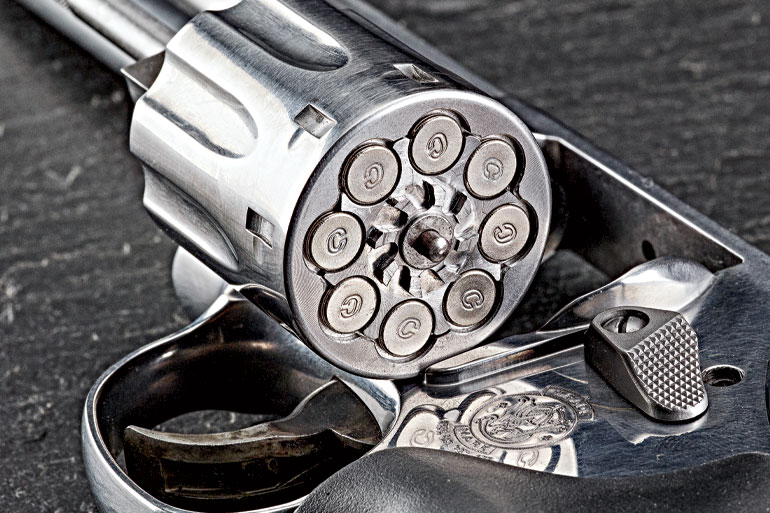
In 6.0-inch-barreled handguns, the .22 WMR churns up velocities running from 1,000 to 1,500 fps depending on the loading. Compared to .22 LR velocities from rifles with barrel lengths running from 18 to 24 inches obtained by shooting subsonic, match, and hunting ammo and chronographing them 12 feet from the guns’ muzzles (actual velocities ranged from 980 fps to 1,340 fps depending on the loading), the .22 WMR is anywhere from 20 fps on the low end to 160 fps on the high end faster. That’s out of a 6.0-inch-barreled handgun. Depending on the specific data, the .22 WMR out of a 6.0-inch handgun barrel produces from 110 ft-lbs to 170 ft-lbs of muzzle energy. That’s definitely enough for shooting small game at typical handgun-hunting distances.

The New Model 648
The original S&W Model 648 revolver was produced from 1989 until 1996 and again from 2003 until 2005, but before it, S&W produced the Model 48 from 1959 until 1986 (it was reintroduced in S&W’s Classics line in 2010). Both the Model 48 and Model 648 were K-Frames, and both originally featured six-shot cylinders. As I stated previously, both were chambered for the .22 Magnum, but an optional .22 LR cylinder was available for the Model 48. The Model 48 was a blued chrome-moly steel revolver (a very few nickel-plated Model 48s were produced, and they command a premium among collectors), and the Model 648 was a stainless-steel revolver. Both models come with fully adjustable rear sights.
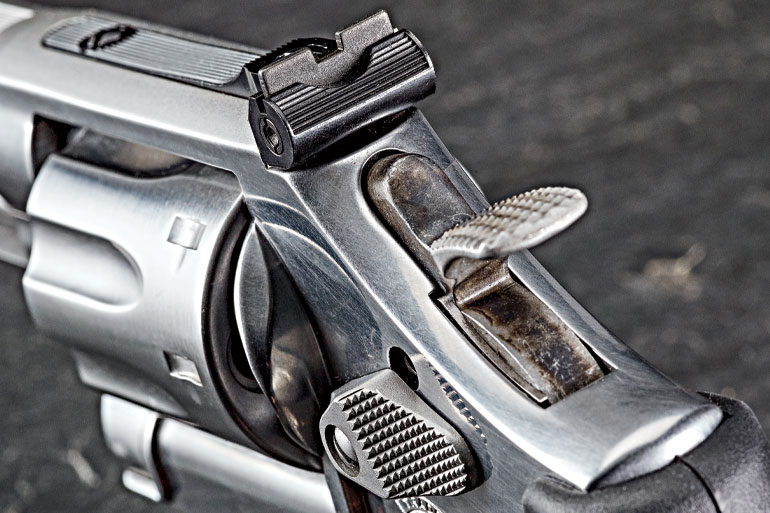
Originally, the Model 48 was offered with 4.0-, 6.0-, and 8.38-inch barrels, while the Model 648 came with only a 6.0-inch, full-lug barrel. The Model 48 had checkered walnut grips, and the Model 648 had smooth Goncalo Alves combat-style grips with finger grooves. (Goncalo Alves is a type of nicely figured wood.) In 1994 S&W changed the Model 648 to black Hogue rubber grips with finger grooves. I owned a vintage 6.0-inch-barreled Model 48 in the late 1980s, and twice I have owned original Model 648s. All were excellent guns, but I have to admit, when I heard that S&W was going to reintroduce the Model 648 with an eight-shot cylinder, I knew I had to have one.
Like the original, the new eight-shot Model 648 revolver is offered with a 6.0-inch full-lug barrel, an adjustable rear sight, and a black Patridge front sight. The Patridge sight is a relatively thick, rectangular, flat-topped post named for its inventor, E.E. Patridge, an American champion revolver shooter during the late19th century. Paired with the square-notch rear sight, the Patridge sight is preferred for target shooting because the vertical alignment is very precise. The Model 648’s front sight is pinned into the barrel. The grips are textured black synthetic with finger grooves and the S&W logo molded into both sides. The grip screw has a Torx head.
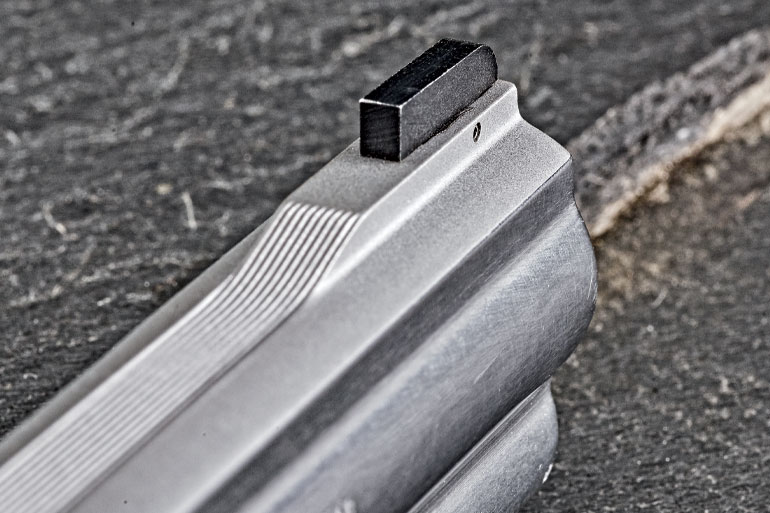
The full-lug barrel gives the revolver a substantial heft. It weighs 46.2 ounces. That probably seems heavy to a lot of readers in this day and age of lightweight carry guns. But I don’t mind the weight. Serious shooters know that if you can handle the weight, a heavier handgun is easier to hold steady. Also, the 6.0-inch barrel gives the Model 648 a sight radius of 7.25 inches. Generally, the longer the sight radius, the less effect any slight sight-alignment error will have on a target downrange.
The Model 648 uses the K/L/N-Frame rounded grip frame that all S&W revolvers currently use. And the synthetic grips are slim and textured. They wrap around the entire grip frame, and the grip circumference is 5.0 inches directly across from the trigger guard.
The revolver’s cylinder is fluted, and the chambers are countersunk. The cylinder measures 1.45 inches in diameter and 1.62 inches in length, and it rotates counterclockwise.
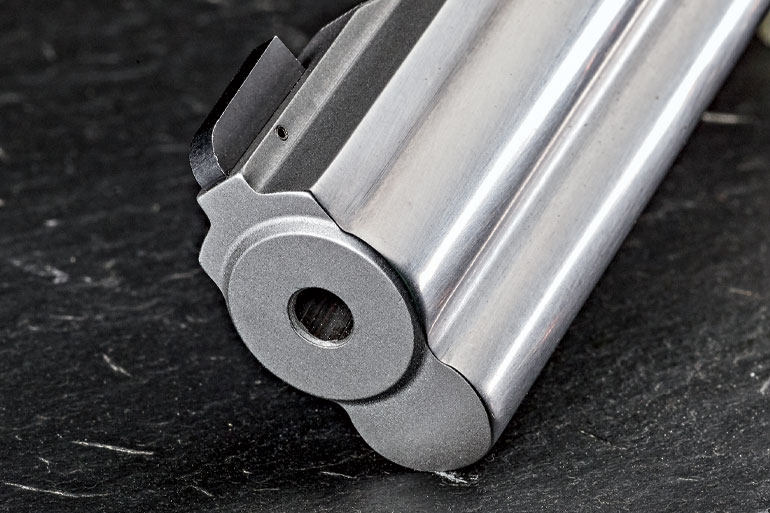
The revolver utilizes Smith & Wesson’s keyed locking system, which is an internal lock that’s activated by the key slot located just above the cylinder release latch on the left side of the revolver. When engaged, it prevents the hammer from being cocked and the trigger from being squeezed. The cylinder release is the newer style.
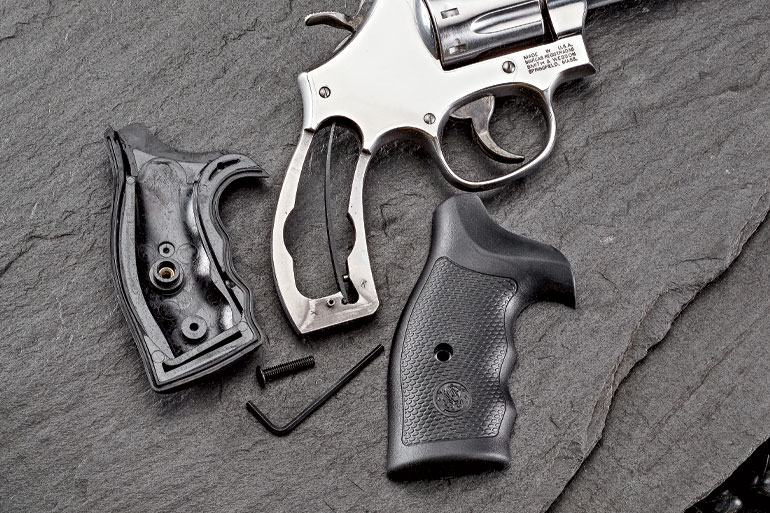
Eight Is Enough
For my shooting tests of the new eight-shot Model 648, I fired eight loads, and I installed a Wiegand scope mount, which I purchased from Brownells. For the accuracy evaluation, I used my favorite handgun scope. The scope is an old, special-edition Burris 1X with very fine crosshairs and a 7.75-minute black dot reticle proportioned to cover slightly more than the X-ring at 25 yards and the 10-ring at 50 yards of a Bullseye target. That scope was designed by my old boss, Gil Hebard, and produced under a special agreement. Gil was a champion Bullseye competition shooter, and he designed the scope for target shooting. We sold a lot of them back when Bullseye competition was at its height in popularity. I never competed in Bullseye matches, but I’ve done plenty of informal target shooting with this scope.
During my second session with the new Model 648 (a morning of squirrel hunting on my rural property), I used a Weaver 2X handgun scope with a plex reticle. I prefer this type of reticle for small-game hunting because the black dot and fine crosshairs of the Burris Bullseye scope sometimes can be difficult to see against the head and body of a dark-colored “tree-top whitetail” (a.k.a. fox squirrel) if the lighting conditions in the timber are less than ideal. Of course, any number of red-dot optics work great for small-game hunting, too, but in my opinion, the full-lugged, 6.0-inch-barreled Model 648 screams for a full-size handgun scope.
The Wiegand scope mount is easy to install by virtue of the drilled-and-tapped topstrap of the Model 648. The revolver’s factory rear sight has to be removed, but that’s an easy task, and the scope mount installs in just minutes. Three screws hold it securely to the gun’s frame.
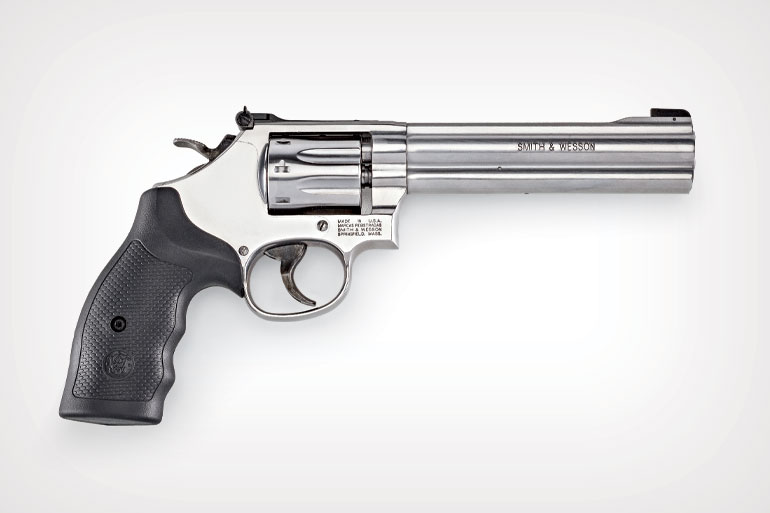
I also used an old set of Herrett custom-made wood grips that fit my hand perfectly. Again, these grips were originally designed for target shooting, but I like them so much, I almost always use them on my favorite S&W K-Frame revolvers. They have a palmswell, a palmrest, and a thumbrest that conform to the shape and size of my right hand. I was smart enough to buy two sets back when I worked for Gil, but I probably should have purchased even more. As they say, hindsight is 20/20.
As for the accuracy and velocity results of shooting the eight loads in the eight-shot Model 648, I was pleased that the gun’s overall average accuracy at 25 yards was 1.89 inches. The most accurate load was the Winchester 40-grain JHP ammo, and its five, five-shot groups averaged 0.75 inch. The second most accurate loading was the CCI Maxi Mag +V 30-grain TNT ammo, and its five, five-shot groups averaged 1.50 inches.
One of my favorite .22 Magnum loadings has always been Federal’s 50-grain JHP. Its SKU is 757. A few decades ago Federal called it Classic, and today it is part of the company’s Game-Shok line. Unfortunately, it didn’t shoot as well in the new Model 648 as I had expected. It was in the middle of the pack in terms of accuracy, averaging 2.33 inches at 25 yards. I don’t consider that to be quite accurate enough for head shots on squirrels. Granted, I only fired five, five-shot groups with it, so I plan on doing some more practice with it in hopes that the average will improve. It may have some potential because its single best five-shot group measured 1.12 inches, and afterall, it usually doesn’t take five shots to drop a squirrel. But the Winchester ammo also had higher energy, so I’ll likely keep hunting with it.
Lately, it seems like revolvers of all makes have been surging in popularity. I’m pleased to see that because I’ve always loved revolvers, both double action and single action. The eight-shot .22 Magnum Model 648 is sort of a specialized revolver and may not be for everyone. I see it primarily as a small-game-hunting tool and camp/trail gun, but it’s also great for casual target shooting and plinking. I’m thinking of it as a .22 Magnum masterpiece.
Smith & Wesson Model 648 .22 WMR Revolver Specs
Manufacturer: Smith & Wesson; smith-wesson.com
Type: Double-action/single-action revolver
Caliber: .22 Winchester Magnum Rimfire
Cylinder Capacity: 8 rounds
Barrel: 6.0 in.
Overall Length: 11.1 in.
Width: 1.45 in.
Height: 5.5 in.
Weight, Empty: 46.2 oz.
Grips: Synthetic
Finish: Polished stainless steel
Sights: Fully adjustable rear, Patridge front
Trigger: 13.5-lb. DA pull, 4.0-lb. SA pull (as tested)
Safety: Key-activated internal locking system
MSRP: $749


|
|||







Here is a 1873 Colt 44=40 that came from the basement of an old hardware store in Placerville (Hangtown) California. Floor was of dirt and pistol and holster had lain there for who knows how long.
The Surefire Ryder 9-Ti2 Sound Suppressor and Springfield Armory XD-M Elite OSP Threaded handgun synergistically combine to become something greater than their parts. The XD-M Elite Tactical OSP (Optical Sight Pistol) reflects the current state of the art in full-sized combat handguns. The Surefire Ryder 9-Ti2 is as fine a handgun suppressor as mankind can create. Thread these two magnificent tools together and strap on a Streamlight TLR-8G to create the most effective combat pistol in the world.
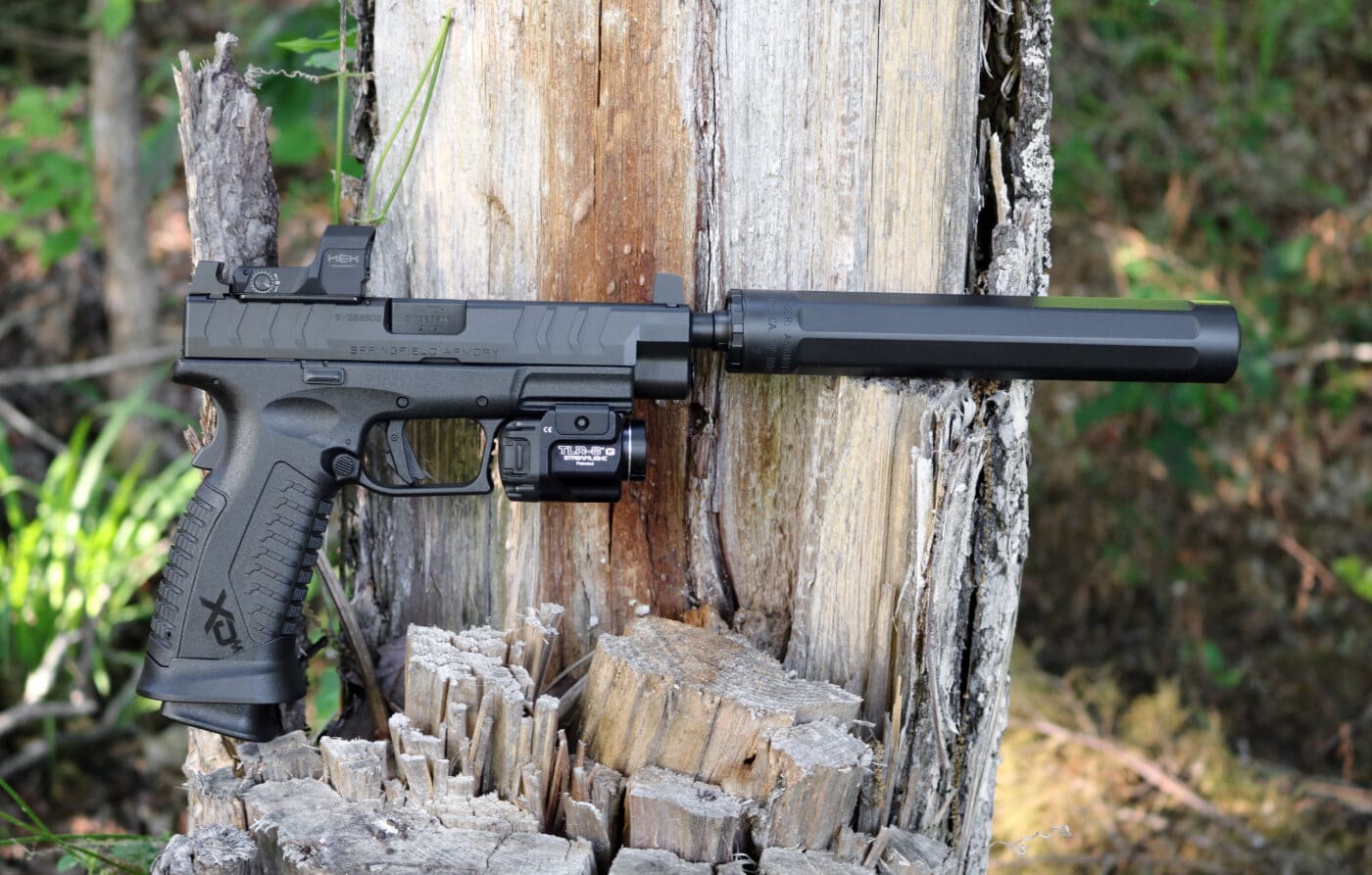
Walter Mitty’s Ideal Suppressed Handgun
I can count on less than one hand the number of times the CIA has tapped me to travel to the other side of the world to rescue a kidnapped supermodel from the clutches of some evil super-villain. In amongst all the shaving cream commercials and trans-oceanic jaunts on the superyacht I bought with the proceeds from my gunwriting who has time for such? Were the President to call, more often than not I’d just tell him I was too busy.
Who am I kidding? I’m a 55-year-old man with worn-out knees, steadily worsening presbyopia, a family, and a mortgage. The only way I might ever rescue a Sports Illustrated swimsuit model in a faraway land would be if absolutely everybody else to include Nancy Pelosi, Pete Buttigieg and Greta Thunberg were otherwise indisposed. However, there yet remains something to be said for maintaining the proper tools in the profoundly unlikely event I might actually get that call.
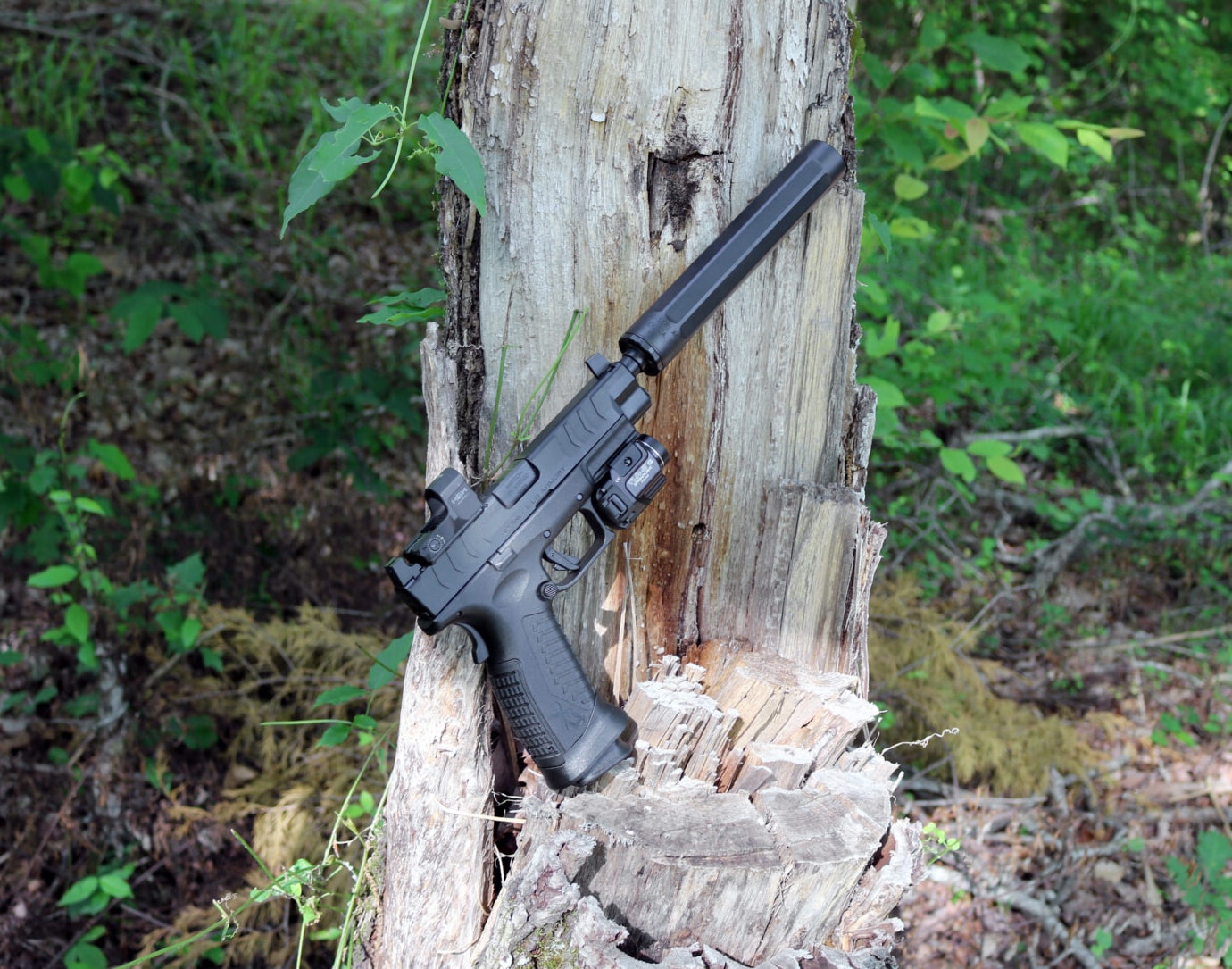
There is something primally satisfying about tactical shooting. I don’t hunt. I have no issues with those who do, but that’s just not my thing. However, the storied art of tactical shooting embodies the timeless allure of power under control. For me at least it’s like golf, only way cooler.
The urge to contrive the optimized tactical handgun spawns from some primordial spaces. Rocking the hottest gun on the range certainly has its appeal. However, unlike a top-end $10,000 Gemspot OM 5 Deluxe Diamond Golf Driver, this rig will actually help keep you and your family safe come what may. This deep into the 21st century the practical applications of a proper tricked-out tactical handgun are fairly obvious.
Practical Tactical
The ideal suppressed handgun system needs to be rugged, accurate, quiet, intuitive and utterly reliable. This weapon should run fast and well while shooting straight and packing a simply breathtaking number of rounds onboard. The symbiotic melding of the Surefire Ryder 9-Ti2 Sound Suppressor, the Springfield Armory XD-M Elite Tactical OSP threaded handgun, and the thumb-sized Streamlight TLR-8G tactical light is all that and more.
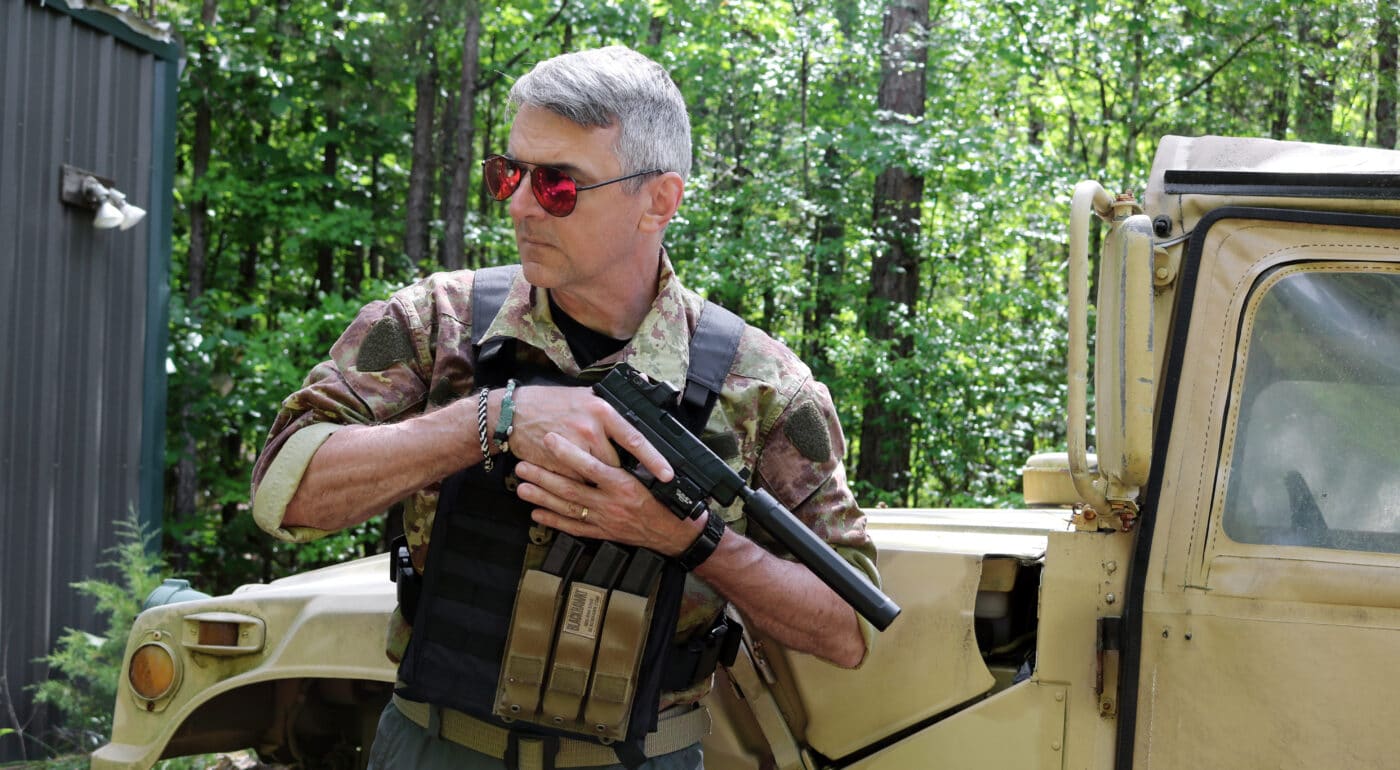
The Surefire Ryder 9-Ti2 is one of the lightest, thinnest, most effective pistol cans in its class. Sporting a svelte tube diameter of 1.25″ and a paltry 10.7-oz. weight, the Ryder 9-Ti2 offers a trivial weight burden. Rugged, mil-certified, heat-treated, sequentially-numbered stainless steel baffles and a fluted titanium outer tube define ballistic greatness. A built-in Linear Inertial Decoupler ensures flawless reliability, while exceptional rigidity and concentricity provide superlative accuracy with a minimal and predictable point of impact shift. The Ryder 9-Ti2 is honestly as good as it gets in my opinion.
The 1.25″ outer tube diameter is about the same width as the pistol grip. This offers relatively unobstructed use of the gun’s sights. It also allows you to holster the piece in certain carry rigs with the suppressor in place. We committed gun nerds prattle on about pistols and suppressors all the time, but there are precious few ways to actually tote the two together. The Ryder 9-Ti2 can get you there.
The Springfield Armory XD-M Elite OSP Threaded Handgun comes from the factory with a 5.28″ hammer-forged threaded barrel, deep cocking serrations both front and rear, and a truly bilateral ambidextrous pushbutton magazine release. The slide release is replicated on both sides of the gun. The META (Match Enhanced Trigger Assembly) offers an inimitably crisp, fast, and safe striker-fired trigger experience.
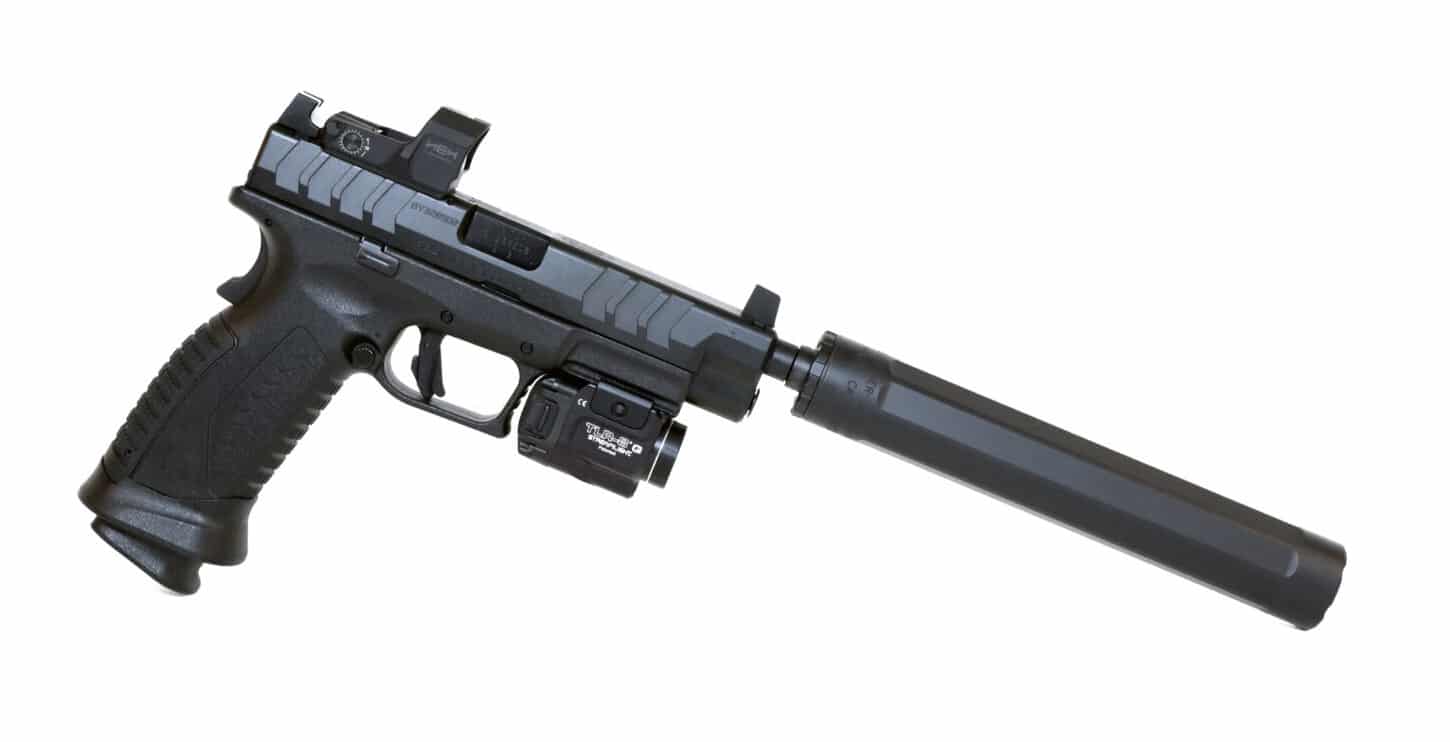
What’s brand new nowadays is the factory-mounted HEX Dragonfly electronic optical sight. This compact, lightweight slide-mounted optic provides a wide uncluttered field of view along with an easily-accessed 3.5-MOA red dot. The battery lasts around three years, so you needn’t fret about it unduly. Replace the battery every odd-numbered birthday, and you’re good. Mount up a Streamlight TLR-8G combination light and laser, and the thing hunts like a bloodhound even indoors or in hard dark.
Trigger Time
The positively epic 22-round magazine that feeds the Springfield Armory XD-M Elite OSP Threaded Handgun lasts just about forever. You can get tired of squeezing the trigger before the box runs dry. That’s entertaining on the range. However, out in the Real World the fastest mag change is the one you don’t have to make. The META trigger and optimized everything conspire to create a delightful and effective shooting experience.

The Ryder 9-Ti2 adds very little weight and even less bulk. What added mass there is reaches out forward to help tame recoil and muzzle flip. All centerfire pistol cans are noisy. However, the Ryder 9-Ti2 employs cutting-edge baffle design to excise the snap from those spunky 9mm rounds. Feed the gun 147-gr. subsonic loads and shoot it in a wide-open space and it is surprisingly easy on the ears. Thread it on, and it will do its part to help preserve your hearing and tactical awareness should you ever have to use this rig indoors or within a vehicle.
The Springfield Armory XD-M Elite Tactical OSP runs like a toddler after Toblerone, and the Surefire Ryder 9-Ti2 Sound Suppressor amps up both the sex appeal and tactical efficiency. The Streamlight TLR-8G shreds the darkness while offering truly surgical short-range targeting. The sum total will ably keep you and yours safe come what may. You may not actually be called upon to rescue a supermodel from a Bond-grade supervillain, but that doesn’t mean you can’t keep the proper tools handy, just in case.
Minute of Mae: Mannlicher 1905
HOW TO DIE WELL BY WILL DABBS, MD
It was late on a Monday evening at the VA hospital. I had been at it since 6 a.m. and was in for a long night and day. I walked into the dimly lit room and could tell at a glance the man was dying.
His breath came thick and heavy. His chest heaved with the struggle. I called him softly by name. To my surprise, he stiffened slightly. I had mistakenly thought him too far gone for conversation. I soon discerned he was lucid and could answer my questions, albeit only in brief spurts.
He was not an exceptionally old man, but he was clearly spent. A combat veteran of the Korean War, he had been diagnosed with a squamous cell carcinoma of his sinuses five years before. The radiation and chemotherapy had burned out his olfactory and optic nerves, leaving him completely blind and without his sense of smell or taste. He was utterly deaf in one ear and had 70% hearing loss in the other. His salivary glands no longer functioned, so he had to constantly sip from a cup of water. He also had a profound diabetic neuropathy that robbed him of sensation in his hands and feet.
In pathetic gasps, he told me the details of his medical odyssey. I got to his social history, and he reported two packs of cigarettes a day, daily alcohol consumption and heavy drug use for 35 years. As he clearly did not drink, smoke or do drugs now, I innocently inquired as to when he had stopped those things.
Without hesitation, he gave me a specific date. I asked him what was significant about that day, and he replied, “That’s when I gave my heart to Jesus.”
This opened the floodgates, and he enthusiastically explained the details of his spiritual transformation. He called himself a messianic Jew, claiming Jesus had forever changed his life.
As I listened enraptured, he told me not to feel sorry for him. He said he hated being sick, but because of his illness, he had been able to lead his daughter and one of his chemotherapy nurses to Jesus. He said he could clearly see God’s will in his illness. The strength and confidence he exuded were superhuman.
By the time I finished the interview, we were both exhausted. I checked his medication orders a final time and put him to bed.
The night was busy, something or other requiring my attention throughout the evening. The next morning, I met the man’s wife and daughter and found their faith was up to the challenge.
The day was long, and he gradually declined. By 6 p.m. the next day, I was thoroughly spent but dropped by to check on my sickest patient before heading home.
He was gasping in an oxygen mask, his wife, daughter and a nurse in attendance. I took his hand and explained I was going home for the night. He took a surprisingly firm grasp on my arm and pulled me close, his strongest voice now little more than a whisper. With his other hand he reached up, removed his oxygen mask and immediately began turning blue. With literally his dying breath, the man prayed for me.
He did not pray for me to alleviate his pain or conjure some miraculous cure. Instead, he prayed for me and my ministry in the hospital. He prayed for the well-being of my family. He prayed I might enjoy the abundant life in Christ he had enjoyed. He prayed until he could no longer speak.
I replaced his oxygen mask and slid to the floor, stunned. Right there, in front of him, his family, the VA nurse and God himself, I wept like a child. I weakly thanked him before heading home, now having quite a lot to ponder.
The next morning, I arrived at the hospital early to find his condition worse still. At 10:47, with my arm around his wife’s shoulders, I watched him die. I had known him less than three days, yet I count him among my dearest friends. He showed me how to die well.
I look forward to seeing him again.



